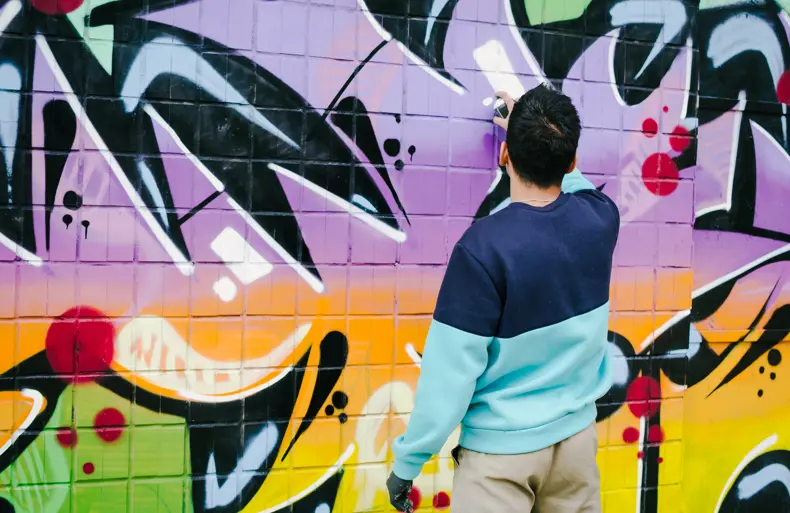Blog | Office Leasing | Offices
From vandalism to valuable the transformation of Shoreditch street art

Shoreditch today is known for its culture. From its buzzing bars and restaurants to its progressive art galleries,‘Shoreditch’ is a byword for all things stylish.
This corner of Hackney is also the home of street art. Once considered vandalism, street art in Shoreditch has been elevated to the mainstream. Street artists, such as the mysterious Banksy and socially-conscious Stik, are no longer outsiders operating on the fringes of legality: their work has become iconic.
Illicit beginnings
Of course, this has not always been the case. Long before Shoreditch was the cultural jewel of the East End, it was a desolate concrete jungle. In the 1970s, vandals took advantage of Shoreditch’s abandoned warehouses, which provided a blank canvas for graffiti and tags.
The graffiti was seen as a sign of urban decay but by the 1980s, tagging had given way to character work. Crews of artists moved through Shoreditch in the dead of night, honing their skills and competing for the most daring locations to display their work.
Street art turned a corner in the 1990s when Banksy burst onto the scene. Known for his sense of humour, Banksy began as a freehand graffiti artist, eventually turning to stencils. The stencils allowed Banksy to work fast and his creations began popping up all over London, although some of his most famous creations are in Shoreditch.
Street art legitimised
In the last decade, street art has shed the last remnants of its bad rep. No longer seen as an anti-social crime, it is now respected as a genuine art form by art institutions and galleries across the capital.
Far from being a sign of urban decay, street art in Shoreditch marks the area as one of London’s cultural hot spots.
Recently, galleries such as the Tate Modern and the Serpentine Gallery have featured work from popular urban artists. Indeed, Banksy’s work will be exhibited in Mayfair’s Lazinc gallery this summer. These polished exhibitions are a far cry from street art’s gritty beginnings.
Today, Shoreditch continues to champion the rise of street art by making efforts to preserve pieces already created and by providing space for new artists to showcase their work and develop their skills. Projects such as BSMT have helped emerging street artists gain recognition by showcasing their work.
Furthermore, Shoreditch street art is a pull for tourists. Guided street-art tours are increasingly popular, reflecting the legitimisation of the artform and cementing Shoreditch’s place in the landscape of modern British culture.
Safeguarding street art for the future
The nature of street art is intrinsically fleeting: buildings bearing the works of famous artists are torn down or artwork painted over. But many of Shoreditch’s most prolific artists often return to the same spots and new creations appear all the time.
Moreover, street art is increasingly protected and a growing number of developers are choosing to preserve the work, ensuring its longevity.
A growing number of developers are commissioning street art to ensure their schemes are in keeping with the local area and are capturing the ethos of the community. For example, at Arnold, a 75,000 sq ft office building in Shoreditch, and department-store-turned-office-space, Dept. W in Whitechapel, graffiti artists were employed to design and create hoarding whilst building work was underway.
Similarly, when we launched Alphabeta, an office and retail space on Finsbury Square, graffiti artists were commissioned to paint the internal walls; and at The Relay Building, contemporary business accommodation in Aldgate, has been elaborately decorated with a graffiti ‘wall tattoo’.
Some worry that with the influx of new development in Shoreditch, new street art creations may dwindle – but it is clear from the above examples that this is unlikely. Whilst Shoreditch is decidedly more upmarket than it was in the 1970s, the nature of street art has also changed. Indeed, research from the Affordable Art fair revealed that nearby street art can add thousands to the value of a property and 29% of Brits would like to commission an artist to paint a mural on the outside of their house. Now a valuable artform, street art has earned its enduring place in the fabric of British culture.
Related Insights

A successful year with 24 promotions, including two new partners
We are pleased to announce 24 firm-wide promotions across our London and Leeds offices, including two new partners. Effective...

The snail-like court system is letting down lenders and renters
Logging on to LinkedIn in the last few weeks, my feed has been filled with landlords, lenders and solicitors highlighting the...

Leasehold, Commonhold & Rental Reforms - key changes & their potential impact
The property landscape in England and Wales is undergoing significant changes, with the introduction of new legislation aimed...

Podcast: Property Market Dynamics - Central London Commercial
Want to know more or would simply like some advice? We hope you find this podcast useful. If you want to know more about topi...